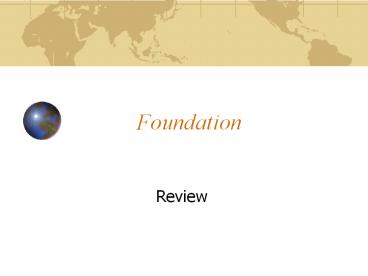Foundation PowerPoint PPT Presentation
1 / 12
Title: Foundation
1
Foundation
- Review
2
The Big Thematic picture
- Theme 1- Interaction between humans and the
environment - Theme 2 Development and interaction of cultures
- Theme 3 State-building, expansion, and conflict
- Theme 4 Creation, expansion, and interaction of
economic systems - Theme 5- Development and transformation of
social structures
3
Some Things to Remember
- Exchange of goods and Ideas over large distances.
The silk Roads, Indian Ocean trade, and the
Mediterranean trade. - The discovery/use of agriculture quickened the
pace of life, and organized areas into sedentary
civilizations - As sedentary civilizations developed, social
structures and gender roles cemented. - Major world religions developed during this
period and spread with along trade routes. - Civilizations became more complex and structured
as time moved on.
4
The Bookends
- 8,000 BCE marks the development of Agriculture
and its spread to the four River Valley
Civilizations (Mesopotamia, Egypt, Indus Valley,
Huang He valley) - 600 CE marks the time by which all the classic
empires had fallen.
5
Details- Neolithic Revolution
- Early modern humans seemed to have developed
farming over time, dropping seeds one year and
then harvesting the crops the next. This led
to settled, formal farming - Domestication and breeding of Animals was also an
important invention - Some humans decided to settle in villages and
soon were able to create a surplus of food. This
lead to diversification of labor, the creation of
governmental structures, and the payment of
taxes! - Other humans chose to become pastoral nomads and
move with their animal herds
6
Details- Technology
- Metallurgy- First copper, then bronze, then Iron.
These increasingly harder metals aided
agriculture tremendously. They also provided
increasingly sophisticated weapons. - Wheel- first used by the sumerians proved helpful
in agriculture, trade, and warfare - Hydrological technology- waterwheels, windmills,
aqueducts proved instrumental in meeting the
water needs of large populations as well as the
irrigation required in drier areas.
7
Details- Demography
- Worlds population increased rapidly with the
advent of farming and domesticated animals. - Waves of diseases plagues increase in frequency
with increased population density - Many classic empires promote population expansion.
8
Details- Social and Gender structures
- Ownership of land signified power
- Kings were usually divine and had absolute power
- Gender roles emerged as farming expanded. Men
worked in the fields while women stayed in the
house. - Whos Your Daddy phenomenon. Women lost power.
- Religion cements and justifies social and gender
structures
9
Details- Cultural and Intellectual Expressions
- Emergence of religions- The emergence of the
Classical age or Axial Age (Emergence of core
belief or philosophical structures of a society.
) - Monumental architecture- Kings show off their
power by building big buildings for either
themselves or the states religion - Writing -as record-keeping becomes paramount,
writing develops - Mathematics- number systems develop. India
creates the Arabic numbers and algebra. - Engineering
10
Details- Structure and Function of State
- First- relatively small states. City-states
- Then- large Coercive tribute empires.
- Empires follow Conrad-Demarest model- grow large
and wealthy, then too large and fragment. - Taxes paid by the farmers/ peasants for the
enjoyment of the elite. Agricultural surplus
allows for large armies.
11
Trade- Cant live without it!
- Trade, especially over land, is important.
- Begins as relatively informal networks.
- Nomadic pastoralists instrumental in development
of long-distance trade. - Ideas, diseases, religions, goods travel
- Silk Roads, Mediterranean Sea, Indian Ocean
- Silk, Spices,Cotton travel east to west
- Glassware, Wool and Linen, Olive Oil travel west
to east
12
Movement of people
- Bantu Migration across Africa
- Polynesian migration across Pacific Ocean

